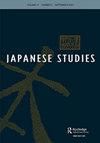Spirit of Place: Zeami’s Tōru and the Poetic Manifestation of Mugen
IF 0.4
Q3 AREA STUDIES
引用次数: 0
Abstract
Abstract Zeami Motokiyo was one of nō’s most important theorists and practitioners, and mugen nō one of his most sophisticated innovations. Using the play Tōru as a model, this article explores how Zeami’s nō utilised waka theory and Buddhist aesthetics that were current in his time. I will particularly focus on his use of utamakura, a poetic device of intertextual allusion via place names. In the second part of the article I will analyse Tōru’s text and music through the lens of Kyoto School philosopher Ueda Shizuteru’s theory of language. In positioning poetic spirits of place on stage, Zeami shows the power of language to manifest something like conventional reality. When watching mugen nō, the music and poetry combine to create a place wherein the audience shares the aesthetic-spiritual experience of the spirit of place manifesting in our communal mind. His staging of the opening up of the hollow expanse is the beauty of Zeami’s art.场所精神:泽米的Tōru与穆根的诗意表现
摘要元木泽美是日本最重要的理论家和实践者之一,而木根是他最复杂的创新之一。本文以戏剧《Tōru》为范本,探讨泽米的《nō;》如何运用他那个时代流行的和合理论和佛教美学。我将特别关注他对utamakura的使用,这是一种通过地名互文典故的诗意手段。本文的第二部分将从京都学派哲学家上田静人的语言理论的角度来分析汤的文本和音乐。在舞台上对诗歌精神的定位上,泽米展示了语言的力量来表现某种传统的现实。在观看mugen nō时,音乐和诗歌结合在一起,创造了一个让观众分享地方精神在我们共同心灵中体现的审美精神体验的地方。他对空旷地带的开放是泽米艺术之美。
本文章由计算机程序翻译,如有差异,请以英文原文为准。
求助全文
约1分钟内获得全文
求助全文

 求助内容:
求助内容: 应助结果提醒方式:
应助结果提醒方式:


